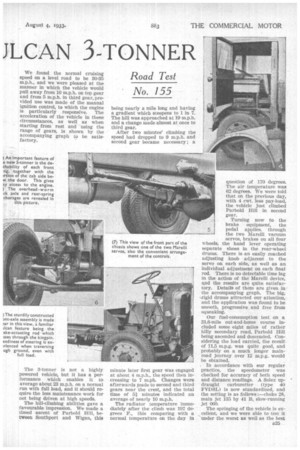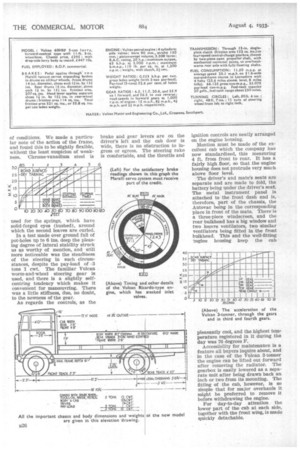A NEW AND LIGHTER \ JLCAN 3;FONNER
Page 34

Page 35

Page 36

If you've noticed an error in this article please click here to report it so we can fix it.
Road Test
No. 155
DETAILS of the modified range of Vulcan commercial vehicles of from 30-35-cwt. to 4-tons pay-load capacity appeared in this paper dated July 7, one of the most important being the new 3-tonner. The Vulcan company felt that there was a market for a 3-tonner which would come within the 2i-ton licensing class, for this would entitle it to a legal speed of 30 m.p.h.
The new machine has, therefore, been produced and is available with either normal or forward control, each in three wheelbase lengths. The normal-control chassis may be had with a wheelbase of 10 ft. 6 ins.,
11 ft. 11i ins. or 13 ft., and the forward control model with a wheelbase of 9 ft. 8 ins., 11 ft. 3 ins. or 12 ft. 2 ins.
Probably one of the most popular forms is that with forward control and a medium wheelbase of 11 ft. 3 ins., this giving a maximum legal body length behind the cab of 14 ft. 6 ins. This is the model we have just tested_
Simplicity and robustness charae1324
terize the design of the 60 H.R.F. 3-tonner. Important features are the Vulcan-built Ricardo-type engine, three-point mounted in unit with a four-speed gearbox, the double propeller shaft with Hardy Spicer mechanical joints and large selfaligning bearing, the 6.5-to-1 overhead-worm axle, and the four-wheel brakes with two Marelli vacuum
servos.
The company has experienced the common problem of vehicles being overloaded by owners, and has now adopted a policy on guaranteeing each model for a given overload. This 3-tonner is guaranteed so long as it does not carry more than 31f -0 tons, the limit being based upon a chassis with standard cab and detachable-sided lorry body.
After our full-day test, which was of a thorough nature in accordance with our standardized road-test practice, we formed the opinion that the vehicle is amply sturdy for such a load. The frame, axles, springs and tyres are all well up to the job, and it is only because of simplicity in design that the unladen weight is kept within the 21-ton class.
As to the power, this is adequate for ordinary purposes. The chassis tested had covered only 38 miles on the road at the time when we took delivery, but it appeared to have an engine that had been well run in on the bench. With a maximum power output of 63 b.p.h. at 3,000 r.p.m., this unit develops 53 b.h.p. at 2,000 r.p.m. and about 30 b.h.p. at 1,000 r.p.m. The best torque development is obtained at between 800 r.p.m. and about 1,400 r.p.m., and is nearly 150 lb.-ft. The maximum brake mean effective pressure is just over 110 lb per square inch at 1200, r.p.m. It is interesting to note that 2,000 r.p.m. corresponds to 30 m.p.h. in top gear. We found the normal cruising speed on a level road to be 30-35 m.p.h„ and we were pleased at the manner in which the vehicle would pull away from 10 m.p.h. on top gear and from 5 m.p.h. in third gear, provided use was made of the manual ignition control, to which the engine is particularly responsive. The acceleration of the vehicle in these circumstances, as well as when starting from rest and using the range of gears, is shown by the accompanying graph to be satisfactory.
The 3-tonner is not a highly powered vehicle, but it has a performance which enables it to average about 23 m.p.h. on a normal run with full load, and it should require the less maintenance work for not being driven at high speeds.
The hill-climbing abilities gave a favourable impression. We made a timed ascent of Parbold Hill, between Southport and Wigan, this being nearly a mile long and having a gradient which steepens to 1 in 7. The hill was approached at 19 m.p.h. and a change made almost at once to third gear.
After two minutes' climbing the speed had dropped to 9 m.p.h. and second gear became necessary ; a minute later first gear Was engaged at about 4 m.p.h., the speed thou increasing to 7 m.ph. Changes were afterwards made to second and third gears near the crest, and the total time of 51 minutes indicated an average of nearly 10 m.p.h.
The radiator temperature immediately after the climb was 197 degrees • P., this comparing with a normal temperature on the day in question of 170 degrees. The air temperature was 62 degrees. We were told that on the previous day, with 4 cwt. less pay-load, the vehicle just climbed Parbold Hill in second gear.
Turning now to the brake equipment, the pedal applies, through the two Mardi vacuum servos, brakes on all four wheels, the hand lever operating separate shoes in the rear-wheel drums. There is an easily reached adjusting knob adjacent to the servo on each side, as well as an individual adjustment on each final rod. There is no detectable time lag in the action of the Mardi device, and the results are quite satisfactory. Details of them are given in the accompanying graph. The big, 'rigid drums attracted our attention, and the application was found to be smooth, progressive and free from squeaking.
Our fuel-consumption test on a 31.6-mile out-and-home course included some eight miles of rather hilly secondary road, Parbold Hill being ascended and descended. Considering the load carried, the result of 11.5 m.p.g. was quite good, and probably on a much longer mainroad journey over 12 m.p.g. would be obtained.
In accordance with our regular practice, the speedometer was cheeked for accuracy of both speed and distance readings. A Solex up
draught carburetter (type 40 FVDSL) is now standardized, and the setting is as follows :—choke 28, main jet 135 by 41 B, slow-running jet 060.
The springing of the vehicle is excellent, and we were able to test it under the worst as well as the best B25
of conditions. We made a particular note of the action of the frame, and found this to be slightly flexible, without the least suspicion of weakness. 'Chrome-vanadium steel is used for the springs, which have solid-forged eyes (bushed), around which the second leaves are curled.
In a test made over ground full of pot-holes up to 6 ins, deep the pleasing degree of lateral stability struck us as worthy of mention, and still more noticeable was the steadiness of the steering in such circumstances, despite the pay-load of 3 tons 1 cwt. The familiar Vulcan worm-and-wheel steering gear Is used, and there is a slightly selfcentring tendency which makes It convenient for manoeuvring. There was a little stiffness, due, no doubt, to the newness of the gear.
As regards the controls, as the
brake and gear levers are on the driver's left and the cab door is wide, there is no obstruction to ingress or egress. The steering rake is comfortable, and the throttle and
ignition controls are neatly arranged on the engine housing.
Mention must be made of the excellent cab which the company has now standardized, this measuring 4 ft. from front to rear. It has a fairly high floor, so that the engine housing does not protrude very much above floor level.
The driver's and mate's seats are separate and are made to fold, the battery being under the driver's seat The metal instrument panel is attached to the front dash and is, therefore, part of the chassis, the Autovac being in the corresponding place in front of the mate. There is a three-piece windscreen, and the rear bulkhead has a big window and two louvre ventilators, two -similar ventilators being fitted in the front bulkhead. This and the well-fitting
• .?ngine housing keep the cab
pleasantly cool, and the highest temperature registered in it during the day was 76 degrees F.
Accessibility for maintenance is a feature all buyers inquire about, and in the case of the Vulcan 3-tonner the engine can be lifted out forward after removing the radiator. The gearbox is easily lowered as a separate unit after being drawn back an Inch or two from its mounting. The fitting of the cab, however, is so simple that for major overhauls it might be preferred to remove it before withdrawing the engine.
For day-to-day attention the lower part of the cab at each side, together with the front wing, is made quickly detachable.




















































































